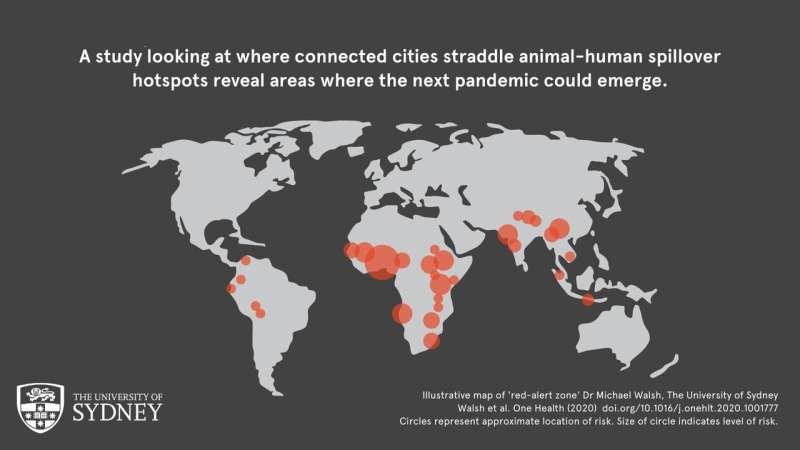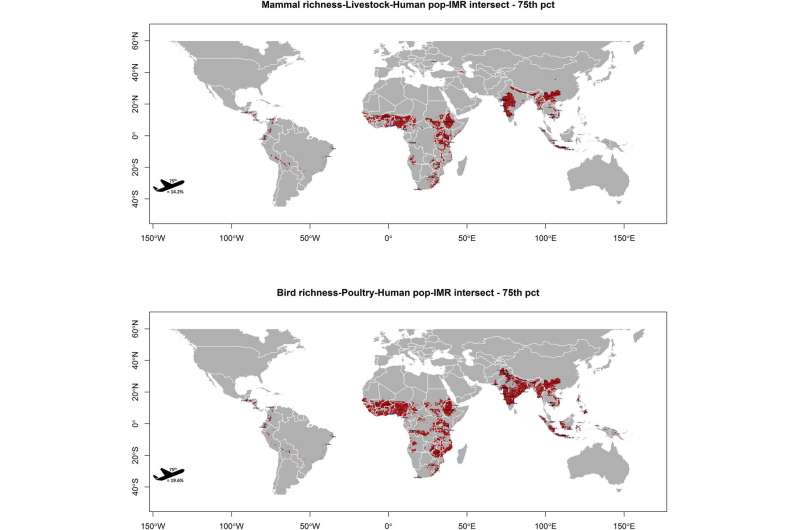Areas where the next pandemic could emerge are revealed

An international team of human- and animal-health experts has incorporated environmental, social and economic considerations—including air transit centrality—to identify key areas at risk of leading to the next pandemic.
An international team of researchers has taken a holistic approach to reveal for the first time where wildlife-human interfaces intersect with areas of poor human health outcomes and highly globalized cities, which could give rise to the next pandemic unless preventative measures are taken.
Areas exhibiting a high degree of human pressure on wildlife also had more than 40 percent of the world's most connected cities in or adjacent to areas of likely spillover, and 14-20 percent of the world's most connected cities at risk of such spillovers likely to go undetected because of poor health infrastructure (predominantly in South and South East Asia and Sub-Saharan Africa). As with COVID-19, the impact of such spillovers could be global.
Led by the University of Sydney and with academics spanning the United Kingdom, India and Ethiopia, the open-access paper shows the cities worldwide that are at risk. Last month, an IPBES report highlighted the role biodiversity destruction plays in pandemics and provided recommendations. This Sydney-led research pinpoints the geographical areas that require greatest attention.
The paper, "Whence the next pandemic? The intersecting global geography of the animal-human interface, poor health systems and air transit centrality reveals conduits for high-impact spillover", has published in the leading Elsevier journal, One Health. City lists for yellow, orange and red alert zones are available in open access.
Lead author Dr. Michael Walsh, who co-leads the One Health Node at Sydney's Marie Bashir Institute for Infectious Diseases and Biosecurity, said that previously, much has been done to identify human-animal-environmental hotspots.
"Our new research integrates the wildlife-human interface with human health systems and globalization to show where spillovers might go unidentified and lead to dissemination worldwide and new pandemics," said Dr. Walsh, from the University of Sydney's School of Public Health, Faculty of Medicine and Health.
Dr. Walsh said that although low- and middle-income countries had the most cities in zones classified at highest risk for spillover and subsequent onward global dissemination, it should be noted that the high risk in these areas was very much a consequence of diminished health systems. Moreover, while not as extensively represented in the zone of highest risk because of better health infrastructure, high-income countries still had many cities represented in the next two tiers of risk because of the extreme pressures the affluent countries exert on wildlife via unsustainable development.

Identifying Areas At Risk
The researchers took a three-staged approach:
- First, identify where the sharing of space between wildlife and humans is greatest, and therefore where spillover events would be expected to be most common. The researchers refer to this as the 'yellow' and 'orange' alert zones of two- and three-way interactions between humans, domesticated animals and wildlife.
- Next, identify where areas of high wildlife-human interface coincide with areas of poor health system performance, which would comprise areas expected to miss ongoing chains of transmission following a spillover event ['red-alert' zone—Figure 4];
- Finally, identify cities within or adjacent to these areas of spillover risk that are highly connected to the network of global air travel, and therefore may serve as conduits for future pandemics (city names in the alert zones can be seen by zooming up on the high-resolution maps)
"This is the first time this three-staged geography has been identified and mapped, and we want this to be able to inform the development of multi-tiered surveillance of infections in humans and animals to help prevent the next pandemic," the paper reads.
Of those cities that were in the top quartile of network centrality, approximately 43 percent were found to be within 50km of the spillover zones and therefore warrant attention (both yellow and orange alert zones). A lesser but still significant proportion of these cities were within 50km of the red alert zone at 14.2 percent (for spillover associated with mammal wildlife) and 19.6 percent (wild bird-associated spillover).
Dr. Walsh said although it would be a big job to improve habitat conservation and health systems, as well as surveillance at airports as a last line of defense, the benefit in terms of safeguarding against debilitating pandemics would outweigh the costs.
"Locally-directed efforts can apply these results to identify vulnerable points. With this new information, people can develop systems that incorporate human health infrastructure, animal husbandry, wildlife habitat conservation, and movement through transportation hubs to prevent the next pandemic," Dr. Walsh said.
"Given the overwhelming risk absorbed by so many of the world's communities and the concurrent high-risk exposure of so many of our most connected cities, this is something that requires our collective prompt attention."
More information: Michael G. Walsh et al, Whence the next pandemic? The intersecting global geography of the animal-human interface, poor health systems and air transit centrality reveals conduits for high-impact spillover, One Health (2020). DOI: 10.1016/j.onehlt.2020.100177





















